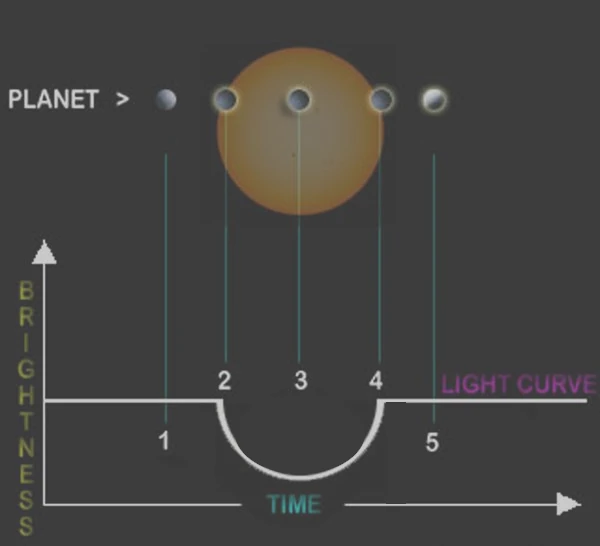
Image Description: A transit (periodic micro-eclipse) occurs each time the planet passes between its star and the observer. At this moment, the planet occults a bit of the star's light, producing a detectable periodic dimming. This remarkable idea is used to detect the planet and directly determine its size and orbit. Image Source: © astronoo
The search for extrasolar planets, or exoplanets, is one of the most fascinating quests in modern astronomy. These planets orbit stars other than our Sun and may potentially harbor forms of life. The detection of these exoplanets relies on several methods, the most common being the transit method.
The transit method involves observing the variations in the brightness of a star when a planet passes in front of it. When an exoplanet transits in front of its star, it blocks a small fraction of the stellar light, resulting in a periodic decrease in the star's brightness. By measuring these variations, astronomers can detect the presence of planets and estimate their characteristics, such as size and orbit.
The fraction of stellar light masked by the exoplanet primarily depends on the ratio of the projected areas of the exoplanet and the star. Basic Formula:
$\delta = \frac{\pi R^*}{\pi R_p} = \left( \frac{R^*}{R_p} \right)^2$(R★) = Radius of the star, for example, approximately 700,000 km for the Sun's radius.
(Rp) = Radius of the planet, for example, approximately 6,371 km for the Earth's radius.
For example, the Earth's radius, which is about 100 times smaller than the Sun's, masks a fraction of the Sun's brightness (1/1002) when it passes between the Sun and a distant observer.
Masking the star to observe the exoplanet's atmosphere is a complex task that requires advanced instruments and techniques. Coronagraphs, interferometry, transit spectroscopy, light subtraction techniques, and space telescopes are some of the methods used to achieve this. These techniques allow astronomers to detect and characterize exoplanets, paving the way for a better understanding of the conditions necessary for the emergence of life beyond our solar system.
Once an exoplanet is detected, the next step is to determine if it could harbor life. To do this, scientists analyze the planet's atmosphere using spectroscopy. By studying the light that passes through the exoplanet's atmosphere during a transit, astronomers can identify the chemical components present, such as oxygen, water, and methane, which are potential indicators of life.
Detecting life on exoplanets presents many challenges. Planets must be close enough to their star for their transit to be observable, but not too close to avoid extreme temperatures. Additionally, current instruments have limitations in terms of sensitivity and resolution, complicating the analysis of exoplanetary atmospheres.
Technological advances, such as space telescopes like Kepler and TESS, have significantly improved our ability to detect exoplanets. The James Webb Space Telescope, launched in 2021, promises to revolutionize this field further by providing more detailed observations of exoplanetary atmospheres.
The search for extrasolar planets and the detection of life are expanding fields. Thanks to methods like the transit method and technological advances, we are getting closer each day to discovering habitable worlds beyond our solar system. These advancements pave the way for a better understanding of our place in the universe and the conditions necessary for the emergence of life.